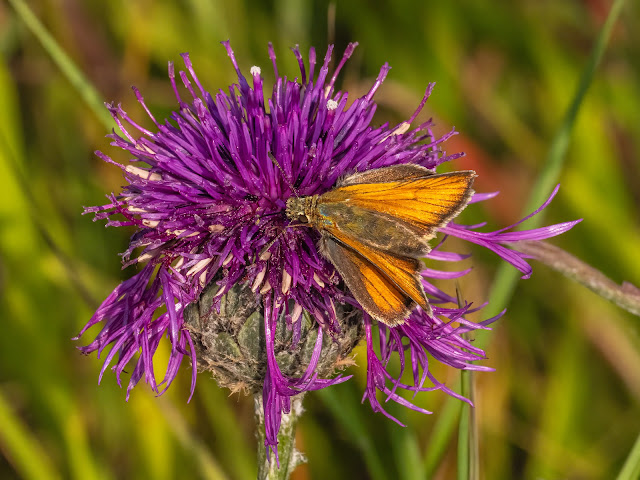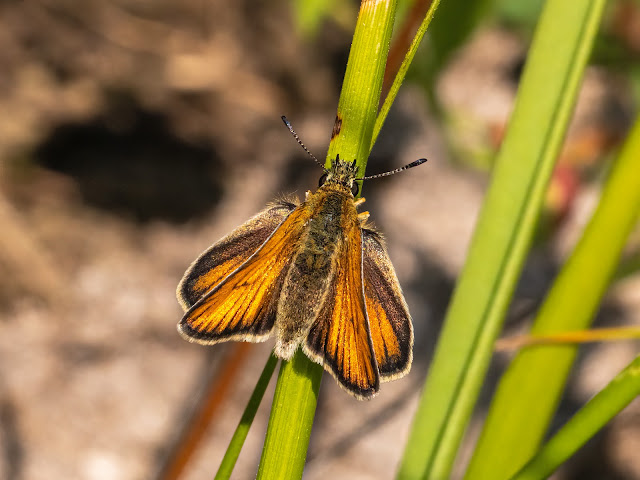On 3rd July 2023, I visited the following sites ….
Broadcroft Quarry, Isle of Portland
I left Woodyhyde Campsite very early to drive 35 miles west to Portland Bill, arriving at 6:45 a.m.
Portland Bill is the Isle of Portland’s southern tip, a 6 mile promontory into the English Channel and the southernmost point of Dorset. The coastline is rocky and just inland there are open fields and quarries. In addition to the Guillemots, Razorbills and Kittiwakes that breed on the cliffs, Portland Bill is one of the most important and productive locations in the UK for seabird passage and a landfall and departure point for spring and autumn migrants.
Photo: Portland Bill
I spent around an hour at Portland Bill, primarily at the obelisk (second photo above) seawatching.
The highlights during my visit, primarily were as follows: Manx Shearwater (3), Gannet (10), Guillemot (at least 30), Razorbill (at least 5), Shag (2), Cormorant (2), Great Black-backed Gull (1), Herring Gull (at least 20), Wheatear (1 male plus 2 fledglings), Rock Pipit (1), Linnet (c.10)
After my visit to Portland Bill, I drove just 3 miles inland and north to Broadcroft Quarry This disused limestone quarry has been turned into a 7.3 hectares nature reserve managed by Butterfly Conservation. It is a great example of how a post-industrial landscape can be restored and be of great value for nature. The stony, calcareous soil supports a herb-rich flora which is key habitat for butterflies and other insects.
Photo: Broadcroft Quarry
Photo: Broadcroft Quarry
The abundance of butterflies was amazing and I managed to record 11 species, including the extremely localised Lulworth Skipper and the Small Blue, 2 species that I had not previously seen.
The highlights during my visit were as follows:
Birds: Common Whitethroat (2 singing males), Swift (2)
Butterflies: Lulworth Skipper (at least 1), Small Skipper (at least 1), Essex Skipper (at least 1), unidentified “golden” skipper species (Small Skipper and/or Essex Skipper and/or Lulworth Skipper) (at least 10), Small Blue (at least 1), Holly Blue (1), Marbled White (at least 30), Ringlet (1), Speckled Wood (1), Red Admiral (1), Gatekeeper (at least 50), Meadow Brown (at least 50)
Moths: Scarlet Tiger (1)
Photo: Small Skipper
Photo: Small Skipper
Photo: Small Skipper
Photo: Small Skipper
Photo: Small Skipper
Photo: Marbled White
Photo: Marbled White
Photo: Marbled White
Photo: Marbled White
Photo: Marbled White and Lulworth Skipper
Photo: Gatekeeper
Photo: Gatekeeper
Photo: Gatekeeper
Photo: Hornet Mimic Hoverfly
Photo: Pyramidal Orchid
Photo: Pyramidal Orchid
Photo: Pyramidal Orchid
Photo: Pyramidal Orchids
After my visit to Broadcroft Quarry, I drove just 3 miles further north and back on to the mainland to visit Chesil Beach at Ferrybridge.
Chesil Beach is 18 miles long and is a pebble and shingle tombolo connecting the Isle of Portland to Abbotsbury and then continuing north west to West Bay near Bridport. It is the largest tombolo in the UK. Chesil Beach forms part of the Dorset and East Devon World Heritage Site and the Jurassic Coast World Heritage Site and it is designated as a Site of Special Scientific Interest (SSSI) and Ramsar site.
Ferrybridge is situated at the beginning of the causeway to the Isle of Portland and is the point at which the Fleet lagoon adjoins Portland Harbour. It is also the location of the Wild Chesil Centre managed by the Dorset Wildlife Trust.
From the Wild Chesil Centre, there is access to the beach where there is an important colony of breeding Little Terns during the spring and summer.
The Chesil Beach Little Tern Project is a partnership project managed by the RSPB and supported by Dorset Wildlife Trust, the Chesil Bank and Fleet Nature Reserve, Natural England, The Portland Court Leet and the Crown Estate. Wardens and volunteers monitor the birds in their breeding colony which is protected by an electric fence.
The main purpose of my visit to Chesil Beach at Ferrybridge was obviously to see the Little Terns and I successfully saw around 15 birds and added another species to my 2023 UK year list.
The slog over the shingle to the Little Tern breeding colony also produced a surprise sighting of a Clouded Yellow plus I saw a pair of Oystercatchers with 2 juveniles on the Fleet lagoon and 6 Linnets near the Wild Chesil Centre.
After my visit to Chesil Beach at Ferrybridge, I drove 32 miles returning east to the Isle of Purbeck and specifically Durlston Country Park and NNR.
Durlston Country Park and NNR is a 320 acre site stretching along the coast of the Isle of Purbeck and situated 1 mile south of Swanage. It is a gateway to the Jurassic Coast World Heritage Site which runs from Exmouth in the west to Old Harry Rocks at Ballard Down just north of Swanage, it forms part of the 630 mile South West Coast Path and it is owned and managed by Dorset Council.
Durlston Country Park and NNR is also designated as Heritage Coast, a Site of Special Scientific Interest (SSSI), a Special Area of Conservation (SAC), an Area of Outstanding Natural Beauty (AONB) and a National Nature Reserve. Our offshore waters are part of the Marine Research Area.
Durlston Country Park and NNR has a mosaic of habitats and hosts a wide range of species. Habitats include sea cliffs, coastal limestone downland, ancient meadows, hedgerows, woodland and dry-stone walls, each with their characteristic plants and animals. These include at least 33 species of breeding butterfly, over 250 species of birds, at least 500 wildflower species, at least 500 moth species and thousands of other invertebrates. The site is an important location for migrating birds in the spring and autumn and the sea cliffs are home to a variety of breeding seabirds including a colony of 400 Guillemots, the second largest on the south coast of England.
The weather during my trip was generally very frustrating. Whilst mostly bright and sunny, there was a very strong wind for most of the time which made watching, and especially photographing, butterflies, dragonflies and damselflies somewhat challenging to say the least.
However, on the coast at Durlston Country Park and NNR, the wind was extremely strong which made my visit less enjoyable and productive than it might have been.
Nonetheless, the abundance of butterflies was still amazing and I was able to again record the extremely localised Lulworth Skipper.
The highlights during my visit were as follows:
Birds (heard only records in italics): Kestrel (1), Chiffchaff (3 singing males), Skylark (2 singing males plus others heard)
Butterflies: Lulworth Skipper (at least 5), Essex Skipper (at least 5), unidentified “golden” skipper species (Small Skipper and/or Essex Skipper and/or Lulworth Skipper) (at least 50), Marbled White (at least 25), Red Admiral (1), Ringlet (1), Speckled Wood (1), Gatekeeper (at least 5), Meadow Brown (at least 20)
Moths: Six-spot Burnet (1)
Photo: Lulworth Skipper
Photo: Lulworth Skipper
Photo: Lulworth Skipper
Photo: Essex Skipper
Photo: Essex Skipper
Photo: Marbled White
Photo: Marbled White
After my visit to Durlston Country Park and NNR, I made the long 170 mile journey home after a thoroughly enjoyable trip. However, I intend to visit again next year in the late spring to catch up with those elusive reptile species and hopefully on less windier days for even better opportunities for watching and photographing butterfly, dragonfly and damselfly species.
#DefendNature .... Please help save and enhance our laws that protect our environment and wildlife





























































No comments:
Post a Comment
If you feel like commenting on my blog, you can contact me by completing the comment form below. I will respond to all comments and enquiries and constructive criticism will always be welcomed.